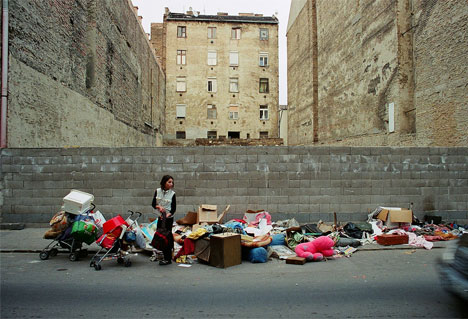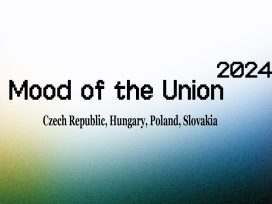The expulsion of a Roma schoolgirl from France, a hunt for allegedly kidnapped blond girls in Roma camps, a ban on begging in Austria; a series of recent events have shed light again on the groups of eastern European Roma who have arrived in the West since their countries became EU members. They don’t arrive in shaky boats or on the backs of lorries, they don’t have to face the dangers of illegal immigration, but they are pushed by misery and discrimination, like the illegal immigrants who died on the shores of Lampedusa in October. Most hope that even the precarious existence they can eke out at the margins of some western society would be better than their situation at home. Some expect that once abroad, the colour of their skin and their social background won’t be an obstacle to their studies and integration. Criminal elements both inside and outside of their groups exploit the extreme fragility of these economic refugees and succeed in organizing a small fraction of them for criminal purposes. This is how they arrive on the front pages of the western newspapers, fomenting further the stereotypes concerning Roma criminality. In order to understand why they leave their homelands, one has to look at their situation there.

Photo: habeebee. Source:Flickr
Hungary is often praised for the treatment of its Roma minority; in fact Roma policy is just about the only domain of the current government’s activity to have received near unanimous praise from EU institutions. One of the highlights of the country’s EU presidency was the launching of the EU Framework for National Roma Integration Strategies. Nevertheless, a closer look at the situation of the Hungarian Roma gives an alarming picture.
Approximately 650-750,000 Roma live in Hungary, amounting to between five and seven per cent of the population. According to the government’s own documents, 70 per cent live in poverty and their life expectancy is ten years lower than that of their non-Roma co-citizens. There are 100 extremely poor “Roma ghetto” villages in the country and a further 200 villages in such a precarious situation as to be likely well on the way to adding to this number. Since 1989, a whole generation of Roma has grown up in precarious conditions without proper infrastructure and social services, in households with parents without regular jobs. Child poverty in Hungary is higher than the EU average and it afflicts Roma children in particular. According to NGOs, two-thirds of Roma children attend segregated classes, which hinders their social integration.
Many economists, social scientists and political activists work on Roma-related issues (including several critics of the former Communist system). There are excellent artistic projects that draw attention to the question, but their impact in informing and raising awareness among the majority society is rather limited. The bulk of Hungarians do not feel concerned by the problems of the Roma and tries to ignore them, often with a mixture of guilt and unease. At the same time, an alarmingly large section of the population has absorbed the increasingly aggressive racist discourse, according to which the Roma are to blame for their situation, which can only be changed with harsh disciplinary measures that separate them from the rest of society or, eventually, lead to their expulsion from the country. Anti-Roma sentiments have always been present in Hungary, but they became more violent, more generalized and more openly expressed in recent years, particularly since the advance of the Hungarian extreme right party Jobbik, which has a markedly anti-Roma political agenda. Research shows a dramatic increase in the prejudiced presentation of the Roma and the assimilation of extreme right discourse into mainstream media during the last decade. When one talks with Roma friends, the conversation inevitably turns to stories of everyday racism that is the lot of most Hungarian Roma, even the educated elite: humiliations and eventual clashes on the streets, in shops, in the schools and government offices, as well as in encounters with the police. Even the very few who succeed in reaching prestigious social positions, from soccer referee to MP, have to deal with racism and discrimination, not only on the streets, but at their workplaces as well, including the Hungarian parliament.
Everyday racism can easily become official policy, as the experience of some Jobbik-led municipalities shows. This includes the village of Gyöngyöspata, the scene of a violent demonstration of force by the extreme Right in 2011. In Fidesz-led Ózd in northern Hungary, during the worst days of a heat wave last summer, local authorities decided to shut down the public wells in order to “avoid spoiling water” supplies. The step hurt the poor and the Roma above all, many of whom don’t have access to running water. The same town refused to host an Ethnic Minority and Roma Cultural Center, the building of which would have been facilitated mostly by EU funds. Three other cities had already refused the proposal; in each case, the Fidesz majority gave in to Jobbik pressure.
Today’s situation is the result of a decades-long process. During the Communist period, once forced industrialization had absorbed the masses of former peasants, it began to draw in large numbers of Roma. From the late 1960s, the majority of Hungary’s Roma were employed, mostly as unskilled labour and predominantly in heavy industry, textiles and construction. It was a forced and partial integration of a still predominantly traditional community, but it came with a large array of measures that significantly improved living conditions, offering better housing, healthcare, social welfare provisions and schooling for Roma. Masses of Roma became integrated members of the working society and a small elite of writers, artists, musicians and political activists emerged who were recognized by the majority society as well.
However, the Roma lost out during the course of systemic change that began in 1989, when 85 per cent of all Roma males were economically active. By 1993, this figure had dropped to 39 per cent and today it is around 20 per cent (only 10 per cent of Roma women are economically active). Simultaneously, along with their mass expulsion from the labour market, the Roma became marginalized due to radical cuts in the state’s health, education and welfare programmes and social security systems. They were gradually pushed back to small villages in the least developed parts of Hungary; in the cities, they concentrated in certain districts that often deteriorated rapidly. Despite the warnings of experts and civil society organizations, none of the post-1989 governments addressed the problem properly, if at all. Short-termist electoral pledges yielded little and the promised improvement projects were gradually abandoned.
In 2010, when Fidesz returned to power, it promised to radically ameliorate the situation. However, Fidesz has handled the Roma issue in exactly the same way it has dealt with all other aspects of social and private life in Hungary: by imposing its own agenda and dismissing alternative views or solutions. The Fidesz-led government marginalized or abolished existing structures and ongoing projects, sidelined independent experts and organizations and created its own policies and institutions, carefully designating the beneficiaries and selecting its partners, who then became the exclusive stakeholders in Roma issues. In May 2011, soon after the EU Roma Strategy was launched, Prime Minister Orbán Viktor and Flórián Farkas, the head of the Roma organization Lungo Drom, signed an “agreement” that promised to deliver 100,000 new jobs for unemployed Roma and train 20,000 Roma to become skilled workers. In addition, at least 10,000 would pass their maturity exams and 5,000 receive university degrees. Farkas, who happens to be a Fidesz MP and a long-time ally of Orbán, became the leader of the highest level Roma representative organization, the National Roma Self-Government (ORÖ). He is also a ministry official in charge of supervising state support for the Roma community. The considerable resources the government and the European Union spend on Roma projects are channelled through agencies created or dependent on this highly centralized and personalized structure.
The Fidesz government at the same time abolished the position of independent ombudsman for national and minority rights (by merging it into a mega-position of Ombudsman of basic rights) and dissolved several public foundations dedicated to Roma issues. Due to lack of support, Radio C and various journals aimed at and produced by Roma had to close down, and the resources of civic initiatives that have worked for years to improve the Roma’s standard of living have been dramatically reduced; many were forced to cease their activities. There are a few privately funded initiatives. The excellent Polgár Alapitvány assists employment creation, community development and talent development in a way that responds to the needs of Roma communities. However, the bulk of projects struggle for survival. These include the Give a Chance to Children Foundation, which helps disadvantaged, principally Roma children to pursue their studies, the Dr Ambedkar Secondary School, which teaches Roma children and their parents until they pass their final exams and the Real Pearl Foundation, which focuses on art education, vocational training courses and family care. The case of Romaversitas demonstrates clearly the logic of government policy. Romaversitas was founded 15 years ago by Roma intellectuals who wanted to help poor and disadvantaged people receive a university education. It has accompanied students throughout their studies, providing grants, training and mentoring as required, as well as finding possibilities to feed and lodge them. The Foundation is now facing a bleak situation because it has not received any state help in the last years and was excluded from the large-scale, mostly EU-funded state-managed project to support special colleges for Roma, on the pretext that it does not have its own building. The considerable development sums were distributed to freshly set-up colleges (several of which used Romaversitas’ expertise to design their application), backed by the government and attached to mainstream religious institutions.
Beyond explicitly Roma-related measures, key policy decisions of the Fidesz-led coalition have dramatically worsened the situation of the Roma. General measures aimed at the poor like the drastic reduction of unemployment benefits, the restriction and conditioning of welfare benefits, measures against the homeless and the punishment of such activities as gathering wood or food in the woods affect the Roma directly. The reduction of the age limit of compulsory education to 16 years is likely to produce new masses of unemployable Roma. Lowering the age for criminal prosecution to 12 years coupled with a particularly harsh new Penal Code is likely to produce further masses of convicted Roma with all the corrosive effects this experience represents. For the majority of Roma today, the only legal opportunity to work and earn money is to participate in the public work system that the government introduced instead of improving education and pursuing active job-creating policies. Job seekers are employed on a temporary basis by local authorities for less than the official minimum wage. They have to accept whatever work is offered to them, often in bad conditions and in the utmost dependence, as a 2012 report of the Ombudsman for basic rights confirmed. In 2013 approximately 300,000 people, predominantly Roma, participated in the project for some months, and only a small minority was able to find stable employment after the experience.
The Roma community is very heterogeneous and divided, which partly explains its very weak political representation. Since 1989, various Roma political organizations have emerged, but none of them aspired to become an independent political force with its own agenda. They have created alliances with mainstream political forces, both on the Left and on the Right, that provided temporary advantages and made possible the creation of rival client systems, instead of genuine interest representation. The present monolithic power structure with its “assigned” Roma representatives and institutions makes genuine political representation even harder. At the end of 2013 a Roma Party of Hungary was established with the purpose of representing the interests of Roma and the poor at the 2014 spring elections. One of the unpleasant surprises of the new election law introduced by the Fidesz-dominated parliament is that voters belonging to ethnic minorities have to choose whether they vote for their minority representatives or for different parties in the next parliamentary elections. As one of the protesting organizations underlined, while Hungarian minorities living abroad who were given voting rights by the Fidesz-led government will be able to vote freely, minorities living in the country would have to choose between their citizen and minority rights. More than 30 independent Roma organizations and several political activists, including the former minority ombudsman, protested against this measure, so far, without result.
The government’s messages concerning the Roma are, to say the least, ambivalent. On the one hand it spends significant sums on its “catching up” projects, promises jobs reserved for Roma in government administration offices, plans to introduce Roma issues in the curriculum and advocates tolerance. On the other hand it tolerates openly racist and anti-Roma rhetoric and discrimination in its own ranks, on the streets, courts and the mostly government-controlled media, gives decorations to personalities that represent the worst xenophobic and racist ideologies and tolerates the existence of uniformed groups that openly call for “cleaning the country” of Roma. According to the Civilian Report prepared by independent Roma and human right organizations, the situation of Hungarian Roma has worsened in the last three years.
However, the life of the Roma in other former Soviet bloc countries, like Romania or Slovakia, from where the bulk of those who end up in the West come, is even worse than in Hungary. No wonder that large groups chose emigration or exile if they can. Police intervention will not prevent this exodus. Long-term, genuine solutions can only be found via coordinated political actions aiming to tackle the roots of the problem: poverty and exclusion, by improving the distribution mechanisms of EU and national funds, by supporting civic and local initiatives that have proved to be efficient in improving the situation, and, inevitably, by including the Roma in the process.
Simultaneously, Europe’s authorities and governments must begin to think about the prevailing system that produces an ever increasing mass of poor and marginalized within their own population while radically dismantling welfare and social networks that could improve their situation. How would a society that abandons its own shipwrecked be able to help others?







